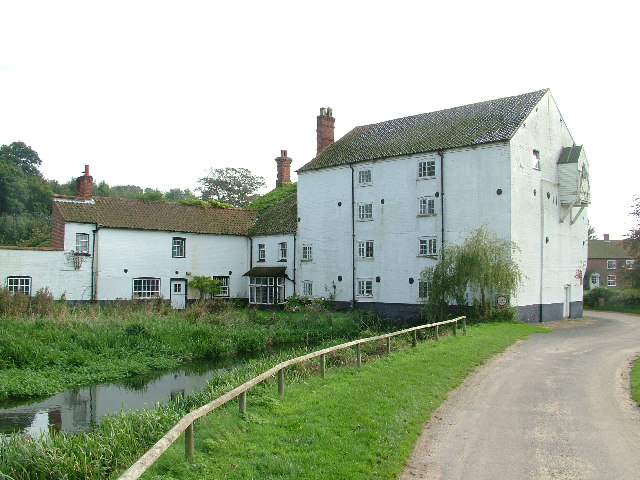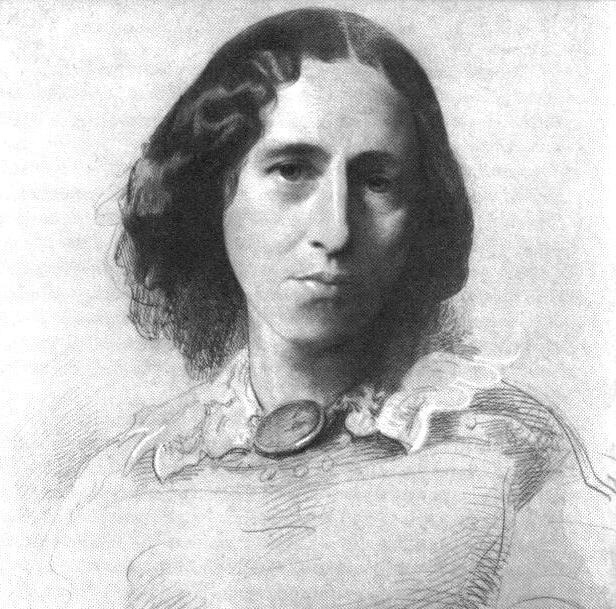|
Bintry Watermill
Bintry Watermill is a historic watermill located on the River Wensum, approximately one mile (2 km) west of the village of Bintree in the English county of Norfolk.OS Explorer Map 238 – Dereham & Aylsham, Castle Acre & Reepham. A watermill has likely occupied this site since 1454. The current structure is believed to have been constructed in the 1750s. Description The present building is constructed from red Norfolk brick, rising four storeys high with a three-bay design on the south-west elevation. The north-west elevation features two columns of windows. The lower two storeys of the mill date back to the 18th century, while the top floor was added in the 19th century. At the western end of the mill, there is a timber lucam (a covered sack hoist) built with shiplap construction. Although the wheelrace still runs beneath the mill, the waterwheel was removed in 1947 to create additional space for electrically powered machinery. Across the road stands a bridge with a dentil ... [...More Info...] [...Related Items...] OR: [Wikipedia] [Google] [Baidu] |
River Wensum
The River Wensum is a chalk river in Norfolk, England, Norfolk, England and a tributary of the River Yare, despite being the larger of the two rivers. The river is a biological Site of Special Scientific Interest and Special Area of Conservation. The Wensum is the principal river on which the city of Norwich was founded. The river passes Carrow Road, the home of Norwich City F.C.; one end of the ground was originally named ''The River End'' in its honour, a name that still persists among fans. Etymology The river receives its name from the Old English adjective ''wandsum'' or ''wendsum'', meaning "winding". Course Modern Ordnance Survey Maps list the source of the Wensum as lying between the villages of Colkirk and Whissonsett in northwest Norfolk. The reasoning behind this claim is unknown given that other tributaries are further from the mouth; pre-modern maps and other written sources refer to the source to be in West Rudham from springs arising on the aptly named Wensum ... [...More Info...] [...Related Items...] OR: [Wikipedia] [Google] [Baidu] |
Bintree
Bintree is a village and civil parish in the English county of Norfolk. The village is about south-east of Fakenham and north-west of Norwich. History Bintree's name is of Anglo-Saxon origin and derives from the Old English for ''Bynna's'' tree. Despite Bintree's Anglo-Saxon origins, there is evidence for much earlier habitation. Archeological evidence include Neolithic tools and Roman pottery & coinage. Bintree is listed in the Domesday Book of 1086 as a settlement of 29 households in the hundred of Eynesford. In 1086, Bintee was divided between the estates of Godric the Steward, Walter Giffard and Hagni the Reeve. In 1759, John Astley became Rector of Bintree whilst also holding the benefices of Brinton and Thornage. In the Nineteenth Century, the Norfolk County School was built within the parish. In 1895, the school was closed and purchased by Edmund Watts who used it to train children from the care of Thomas John Barnardo for service with the Royal Navy. T ... [...More Info...] [...Related Items...] OR: [Wikipedia] [Google] [Baidu] |
England
England is a Countries of the United Kingdom, country that is part of the United Kingdom. It is located on the island of Great Britain, of which it covers about 62%, and List of islands of England, more than 100 smaller adjacent islands. It shares Anglo-Scottish border, a land border with Scotland to the north and England–Wales border, another land border with Wales to the west, and is otherwise surrounded by the North Sea to the east, the English Channel to the south, the Celtic Sea to the south-west, and the Irish Sea to the west. Continental Europe lies to the south-east, and Ireland to the west. At the 2021 United Kingdom census, 2021 census, the population was 56,490,048. London is both List of urban areas in the United Kingdom, the largest city and the Capital city, capital. The area now called England was first inhabited by modern humans during the Upper Paleolithic. It takes its name from the Angles (tribe), Angles, a Germanic peoples, Germanic tribe who settled du ... [...More Info...] [...Related Items...] OR: [Wikipedia] [Google] [Baidu] |
Privately Held Company
A privately held company (or simply a private company) is a company whose Stock, shares and related rights or obligations are not offered for public subscription or publicly negotiated in their respective listed markets. Instead, the Private equity, company's stock is offered, owned, traded or exchanged privately, also known as "over-the-counter (finance), over-the-counter". Related terms are unlisted organisation, unquoted company and private equity. Private companies are often less well-known than their public company, publicly traded counterparts but still have major importance in the world's economy. For example, in 2008, the 441 list of largest private non-governmental companies by revenue, largest private companies in the United States accounted for $1.8 trillion in revenues and employed 6.2 million people, according to ''Forbes''. In general, all companies that are not owned by the government are classified as private enterprises. This definition encompasses both publ ... [...More Info...] [...Related Items...] OR: [Wikipedia] [Google] [Baidu] |
Norfolk
Norfolk ( ) is a Ceremonial counties of England, ceremonial county in England, located in East Anglia and officially part of the East of England region. It borders Lincolnshire and The Wash to the north-west, the North Sea to the north and east, Cambridgeshire to the west, and Suffolk to the south. The largest settlement is the city of Norwich. The county has an area of and a population of 859,400. It is largely rural with few large towns: after Norwich (147,895), the largest settlements are King's Lynn (42,800) in the north-west, Great Yarmouth (38,693) in the east, and Thetford (24,340) in the south. For local government purposes Norfolk is a non-metropolitan county with seven districts. The centre of Norfolk is gently undulating lowland. To the east are the Broads, a network of rivers and lakes which extend into Suffolk and which are protected by the Broads Authority, which give them a similar status to a National parks of England and Wales, national park. To the west the ... [...More Info...] [...Related Items...] OR: [Wikipedia] [Google] [Baidu] |
Shiplap
Shiplap is a type of wooden board used commonly as exterior siding (construction), siding in the construction of residences, barns, sheds, and outbuildings. Exterior walls Shiplap is either rough-sawn or milled pine or similarly inexpensive wood between wide with a rabbet on opposite sides of each edge. The rabbet allows the boards to overlap in this area. The profile of each board partially overlaps that of the board next to it creating a channel that gives shadow line effects, provides excellent weather protection and allows for dimensional movement. The term "shiplap" is often used to describe any rabbeted siding material that overlaps in a similar fashion. Useful for its strength as a supporting member, and its ability to form a relatively tight seal when lapped, shiplap is usually used as a type of siding for buildings that do not require extensive maintenance and must withstand cold and aggressive climates. Rough-sawn shiplap is attached vertically in post and beam cons ... [...More Info...] [...Related Items...] OR: [Wikipedia] [Google] [Baidu] |
Dentil
A dentil (from Lat. ''dens'', a tooth) is a small block used as a repeating ornament in the bedmould of a cornice. Dentils are found in ancient Greek and Roman architecture, and also in later styles such as Neoclassical, Federal, Georgian Revival, Greek Revival, Renaissance Revival, Second Empire, and Beaux-Arts architecture. Dentillation refers to use of a course of dentils. History Origin The Roman architect Vitruvius (iv. 2) states that the dentil represents the end of a rafter (''asser''). It occurs in its most pronounced form in the Ionic temples of Asia Minor, the Lycian tombs, and the porticoes and tombs of Persia, where it clearly represents the reproduction in stone of timber construction. The earliest example is found carved into the rock of the tomb of Darius, c. 500 BC, reproducing the portico of his palace. Its first employment in Athens is in the cornice of the caryatid portico of the Erechtheum (480 BC). When subsequently introduced into the bed-mould of the ... [...More Info...] [...Related Items...] OR: [Wikipedia] [Google] [Baidu] |
George Eliot
Mary Ann Evans (22 November 1819 – 22 December 1880; alternatively Mary Anne or Marian), known by her pen name George Eliot, was an English novelist, poet, journalist, translator, and one of the leading writers of the Victorian era. She wrote seven novels: ''Adam Bede'' (1859), ''The Mill on the Floss'' (1860), ''Silas Marner'' (1861), ''Romola'' (1862–1863), ''Felix Holt, the Radical'' (1866), ''Middlemarch'' (1871–1872) and ''Daniel Deronda'' (1876). Like Charles Dickens and Thomas Hardy, she emerged from provincial England; most of her works are set there. Her works are known for their literary realism, realism, psychological fiction, psychological insight, sense of place and detailed depiction of the countryside. ''Middlemarch'' was described by the novelist Virginia Woolf as "one of the few English novels written for grown-up people"Woolf, Virginia. "George Eliot." ''The Common Reader''. New York: Harcourt, Brace, and World, 1925. pp. 166–176. and by Martin Amis an ... [...More Info...] [...Related Items...] OR: [Wikipedia] [Google] [Baidu] |
The Mill On The Floss
''The Mill on the Floss'' is a novel by English author George Eliot, pen name of Mary Ann Evans, first published in three volumes on 4 April 1860 by William Blackwood and Sons. The first American edition was published by Harper & Brothers, Publishers, New York. Spanning a period of 10 to 15 years, the novel details the lives of Tom and Maggie Tulliver, siblings who grow up at Dorlcote Mill on the River Floss. The mill is at the confluence of the Floss and the smaller River Ripple, near the village of St Ogg's in Lincolnshire, England. Both the rivers and the village are fictional. Plot The novel begins in the late 1820s or early 1830s – several historical references place the events in the book after the Napoleonic Wars but before the Reform Act 1832. (In chapter 3, the character Mr Riley is described as an "auctioneer and appraiser thirty years ago", placing the opening events of the novel in approximately 1829, thirty years before the novel's composition in 1859. In chap ... [...More Info...] [...Related Items...] OR: [Wikipedia] [Google] [Baidu] |
Emily Watson
Emily Margaret Watson (born 14 January 1967) is an English actress. She began her career on stage and joined the Royal Shakespeare Company in 1992. In 2002, she starred in productions of ''Twelfth Night'' and ''Uncle Vanya'' at the Donmar Warehouse, and was nominated for the Laurence Olivier Award for Best Actress, Olivier Award for Best Actress for the latter. She was nominated for the Academy Award for Best Actress for her debut film role as a newlywed in Lars von Trier's ''Breaking the Waves'' (1996) and for her portrayal of Jacqueline du Pré in Anand Tucker's ''Hilary and Jackie'' (1998). Watson's other films include ''The Boxer (1997 film), The Boxer'' (1997), ''Angela's Ashes (film), Angela's Ashes'' (1999), ''Gosford Park'' (2001), ''Punch-Drunk Love'' (2002), ''Red Dragon (2002 film), Red Dragon'' (2002), ''The Life and Death of Peter Sellers'' (2004), ''Corpse Bride'' (2005), ''Miss Potter'' (2006), ''Synecdoche, New York'' (2008), ''Oranges and Sunshine'' (2010), '' ... [...More Info...] [...Related Items...] OR: [Wikipedia] [Google] [Baidu] |
Bernard Hill
Bernard Hill (17 December 1944 – 5 May 2024) was an English actor. He was known for his versatile roles in both television and film, and his career spanned over fifty years. Hill first gained prominence as the troubled hard man Yosser Hughes in Alan Bleasdale's ''Play for Today'' drama ''The Black Stuff'' (1980) and its sequel serial ''Boys from the Blackstuff'' (1982), the latter earning him a nomination for the BAFTA TV Award for Best Actor. He received an additional nomination for his role as David Blunkett in the drama ''A Very Social Secretary'' (2005), for which he was also nominated for an International Emmy Award for Best Performance by an Actor. He also appeared on television in ''I, Claudius'' (1976), the BBC Television Shakespeare productions of '' Henry VI, Part 1'', '' 2'', and '' 3'', and ''Richard III'' (all 1983), ''Great Expectations'' (1999), and ''Wolf Hall'' (2015). Hill gained international recognition for his film roles as Captain Edward Smith in ' ... [...More Info...] [...Related Items...] OR: [Wikipedia] [Google] [Baidu] |





